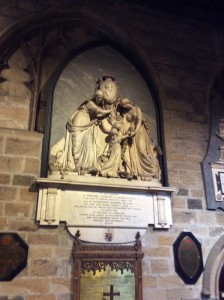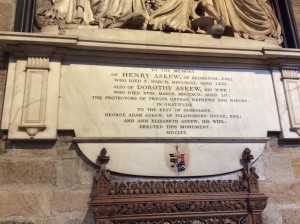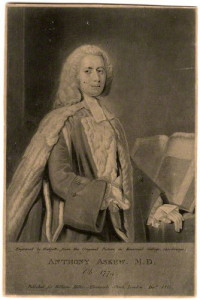by Helen King (monthly contributor)
 How are you at combining your work and your family? It’s a question which exercises many of us, and it came to mind again last week. I’ve always liked visiting cathedrals, and I’ve always been interested in funerary monuments. So on a trip to north-east England, when I was briefly in Newcastle-upon-Tyne, I made a point of revisiting the Anglican Cathedral there. I was struck by one particular monument and wanted to know the story behind it. It’s an unusual monument because it commemorates a childless man and his wife, Henry (d. 1796) and Dorothy (d. 1792) Askew, who took in twelve – twelve! – orphaned children.
How are you at combining your work and your family? It’s a question which exercises many of us, and it came to mind again last week. I’ve always liked visiting cathedrals, and I’ve always been interested in funerary monuments. So on a trip to north-east England, when I was briefly in Newcastle-upon-Tyne, I made a point of revisiting the Anglican Cathedral there. I was struck by one particular monument and wanted to know the story behind it. It’s an unusual monument because it commemorates a childless man and his wife, Henry (d. 1796) and Dorothy (d. 1792) Askew, who took in twelve – twelve! – orphaned children.
The monument doesn’t explain why this happened, so I started digging. It turns out that Henry Askew was one of four sons of Dr Adam Askew and his wife Anne. Adam’s eldest son, Anthony, followed him into the medical profession. After the death of Anthony’s first wife, he married his second wife, Elizabeth. She died in 1773, and Anthony himself died in 1774 at the age of 52. The couple left six sons, and six daughters. It must then be these children who were taken in by their uncle Henry.
 One of the children, Ann-Elizabeth, named as one of the two people dedicating this monument to “the best of guardians”, went on to marry the other dedicator, her cousin George-Adam, the son and heir of the youngest of another of the four Askew brothers, John. This makes the family tree rather complicated. Ann-Elizabeth and George-Adam married in 1795, three years after Ann-Elizabeth’s foster mother Dorothy died, one year after John died, and the year before Henry’s own death.
One of the children, Ann-Elizabeth, named as one of the two people dedicating this monument to “the best of guardians”, went on to marry the other dedicator, her cousin George-Adam, the son and heir of the youngest of another of the four Askew brothers, John. This makes the family tree rather complicated. Ann-Elizabeth and George-Adam married in 1795, three years after Ann-Elizabeth’s foster mother Dorothy died, one year after John died, and the year before Henry’s own death.
This was a very medical family. As well as Adam and Anthony, the generous Henry also practised medicine. But one of those men is famous for something else too. Anthony Askew was a very famous bibliophile. He collected not only medical books, but early editions of Greek and Roman writers. After his death in 1774, the books from his exceptional library were put up for auction in spring 1775.
It was said of Anthony Askew that he “made bibliomania fashionable”. Some of his books were bought by William Hunter, others by the Kings of France and England, and others by the British Museum, so it’s possible I’ve used some myself when doing research in the British Library. His manuscripts were sold at a separate auction in 1785. The Royal College of Physicians’ account of his life says that “His house was crammed full of books, the passages were full, the very garrets overflowed, and the wags of the day used to say that the half of the square itself would have done so before the book appetite of Dr. Askew would have been satiated.” He’s clearly a man after my own heart.

by Thomas Hodgetts, published for William Richard Beckford Miller, after Allan Ramsay, mezzotint, published December 1811
The account goes on to confirm that “Dr. Askew was twice married: 1st, to Margaret, daughter of Cuthbert Swinburn, esq., of Long Witton, and the Westgate in Northumberland, but had no issue by her; 2ndly, to Elizabeth, daughter of Robert Holford, esq., a master in chancery, by whom he had six sons and six daughters.”
And that’s it. No mention of what happened to those children at his death, and no mention of how twelve children and a book collection managed to co-exist. He seems to have two separate lives: the bibliophile and collector, and the father of twelve. Reference works tell you all about the former, but nothing of the latter. Yet Anthony Askew is just one person! And I’d love to know more about how his family life worked.
